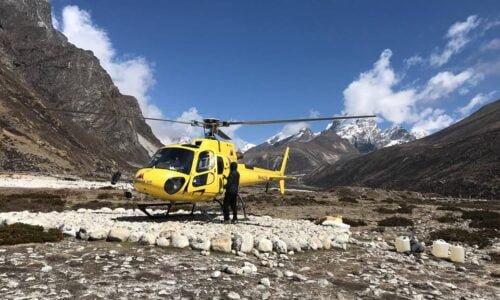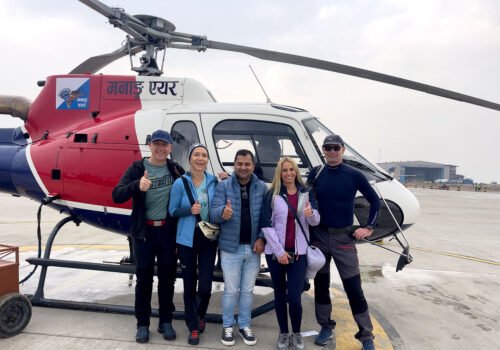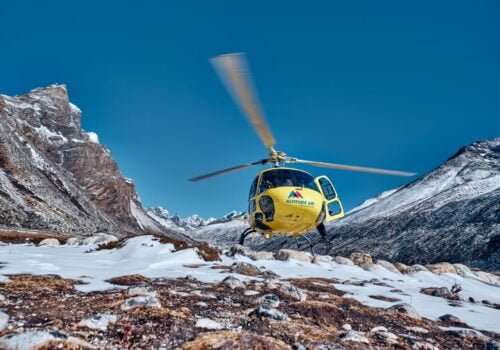Although our Himalayan Helicopter Tours are meant chiefly for those who do not have enough time or are constrained by age or other physical disabilities from going into physically demanding treks and hikes in the regions, these flights are becoming increasingly popular and ever more participated by every type of people. In fact, all those who want, at least once in their lifetime, to have a view of the parts of the earth found nowhere else board them. Even though you have trekked through the regions, the flights bring an altogether different experience as you get to watch everything from above.
The Himalayan region of Nepal, within its width of about 30 kilometers, has eight 8000-meter-plus peaks, thousands exceeding 6000 meters, awesome glaciers, deep gorges, spectacular glacial lakes, and dozens of serpentine rivers originating in these mighty mountains. The Himalayan Helicopter Tours are conducted by two types of helicopters: Eurocopter (AS 305 B) with 5 seats excluding the pilot and the Russian made MI-17 helicopter with the capacity of carrying 22 passengers. They can fly up to an altitude of 16, 000 feet, giving you breathlessly close-up views of the mountains.
While snow permanently covers the greater heights of this region above 5000m, the subtropical climate with deep vegetation can be found almost at the foothills of the same snow-clad peaks because Nepal is located at 26.22’ north to 30.27’ north latitude. Therefore the Himalayan Helicopter Tours also showcase an incredible diversity of terrain and ecosystems ranging from the alpine to the subtropical, all compacted into a narrow range. From the jagged mountain terrain with the mountain peaks that rise straight to pierce the sky, the deep ravines and high altitude plateaus to the deep valleys and lush forests in the bottoms of the bare mountains - the sights you shall see make you hold your breath every moment
At present, Himalayan Helicopter Tours are available in the following regions.
Everest Region: Known also as the Khumbu region, the Everest region is the home to the world’s tallest mountain. This section of the Himalayas range, which extends from the Indus River in the west to the Brahmaputra in the east, has the highest elevation in the entire range. It is also the most varied and the most rugged region in the entire Himalayan Mountains. As you fly over this region, you will see Everest, Lhotse, Choyu (these going over eight thousand), and other big and small peaks numbering to nearly 200 hundred. Besides, there are glaciers, glacial lakes, gorges, and river heads flowing down through mountain slopes. Perfectly superb scenery indeed, you will say yourself.
Langtang Region: This region lies to the north of Kathmandu valley and Rasuwa district. The tallest peak of this range is Langtang Lirung (7245m). As you see through your window, the geographic variety will strike you the most. The Kathmandu will be a plain patch of land, turned into much of an eyesore because of concrete buildings. But immediately north, you will see mountains covered with thick forests. The mountain ridges that culminate in the snow-clad peaks will still be clad with thick subtropical vegetation in the low lying areas. Rivers and streams will be seen crisscrossing and flowing through mountain gorges, creating plateaus. In such a small area, it is hard to find this level of diversity in any other places of the earth.
Annapurna Region: Annapurna region lies in Manang district of Nepal. As you fly over this area, you will start seeing two parallel ranges of snow-covered peaks in the further west. The one in the south is the Greater Himalayan Range with the Annapurna range and the other range running in the north makes the natural border between Nepal and Tibet. The area between these two ranges, which starts in Manang and reaches all the way to the western border of Nepal, looks like the desert with barren hills and slopes. This is because the clouds are blocked by the Greater Himalayan range, thus forcing them to drain all the rain in the south of this range. As a result, the areas in the north fall under rain shadow, receiving scanty rainfall in the whole year.



